Posted By Cindy March 13, 2012
Hog producers have adjusted to higher corn prices and can now even afford to pay more than ethanol producers for corn and still make money.
 “This is an amazing difference from just five years ago,” said Purdue agricultural economist Dr. Chris Hurt. “The hog industry was largely set up with $2-2.50 corn going into 2006. After that we saw major increases in those corn prices.” Dr. Hurt spoke to swine veterinarians on the topic of “Global Feed Economics in a Biofuel World” during recent seminar put on by Boehringer Ingelheim Vetmedica (BIVI).
“This is an amazing difference from just five years ago,” said Purdue agricultural economist Dr. Chris Hurt. “The hog industry was largely set up with $2-2.50 corn going into 2006. After that we saw major increases in those corn prices.” Dr. Hurt spoke to swine veterinarians on the topic of “Global Feed Economics in a Biofuel World” during recent seminar put on by Boehringer Ingelheim Vetmedica (BIVI).
Hog producers initially absorbed those higher costs by reducing margins, which meant big losses and ultimately resulted in reduced supplies. “You reduce the supply enough, you bring those hog prices up. That’s where we are today. Hog producers can pay $6-7 for corn with the prices they’re getting for hogs,” he said. “That up to $7 is higher than ethanol plants can pay for corn and still cover all their costs.”
Dr. Hurt is certain that the days of $2 corn are over, but he does expect prices to moderate around $5-5.50 a bushel.
Listen to an interview with Dr. Hurt here: Dr. Chris Hurt
Dr. Steve Pollmann, President of Western Operations for Murphy-Brown, LLC also spoke at that same seminar about how the world’s largest pork producer has adapted to higher corn prices. As the live production part of Smithfield Foods, Murphy-Brown has about 850,000 sows located in 12 different states and produces about 17 million pigs a year.
“We all know that feed is the biggest single cost of production,” Steve said. “A 25 cent change in corn price per bushel, with that comes a $20 change in soybean price, all of the sudden you’ve got a $1.60 a hundredweight cost of production (increase).” He says the higher feed costs in the last five years or so have meant feed as a percentage of total production costs has risen from 60% to 70%.
Dr. Pollmann says Murphy-Brown adjusted to the higher feed costs by becoming more efficient. “When things get difficult, you’ve got to get better and if you don’t, you die,” he said.
Listen to my interview with Dr. Pollmann here: Dr. Steve Pollman, Murphy-Brown
Increased efficiency in hog operations has meant diversifying feed sources, and that has included adding more distillers grains (DDGs), the animal feed by-product of ethanol. Listening to the speakers at the BIVI seminar made me feel very hopeful that the days of animosity between the livestock and ethanol sectors over corn may actually be coming to an end.
Posted By Cathryn February 13, 2012
For years now, musicians and actors have taken time out from patting themselves on the back during awards ceremonies to advance politicized causes. The mega-produced shows, which take a public willingness to indulge the already pampered in self-congratulation all the way to the bank, now serve as a platform for entertainers to remind us that they are thoughtful, culturally-aware types. Seemingly, it wasn’t enough for them to be richer and more attractive. Now, they have to prove an intellectual and moral superiority by raising a ruckus on the hot issue of the day.
At the Grammy Awards this year, Chipotle cashed in on this trend releasing a two-minute commercial decrying the evil of modern animal agriculture. Willie Nelson, long known to be a fan of a different type of farmer, strummed and sang to a Coldplay tune as cartoon images of a farmer and sweet little cartoon piggies drifted across the screen.
Personal repulsion to the insufferably self-aggrandizing, overly-produced, pseudo-intellectual impersonation of actual pain that underlies Coldplay’s music aside, the commercial plays upon the tendency of people to project what they want onto what they see.
Without a word, the ad strums along with melancholy nostalgia. The pictures show that many animals now, yes, live in barns. The sweet little cartoon pigs are shown actually locked behind a jail cell door like criminals. The farmer debates medicating himself, as shown through a thought bubble with a pill inside, or releasing his pigs back into pastures and blue sky with chickens running about too.
Luckily, it isn’t an actual depiction of how tender piglets might fare in a cold Iowa winter or how chickens do interact when left to their own devices. Instead, it is the same sort of wishy-washy, rose-tinted vision that most people would like to be true, despite the many difficulties with the realities of such a situation. If you are already projecting an actual message for Chipotle, it isn’t a stretch to willfully block out the fiction underpinning the situation.
Instead of buying into the portrayal of agriculture in the commercial, Nebraska farmers and ranchers fought back by showing the amazing story of the livestock industry in a commercial of their own. With solid information presented by actual human beings, the ad stands in stark contrast to Chipotle’s. Unlike its counterpart it offers a forthright message too – Farming is ethical. Learn about it and become a fan.
As a public, we should applaud this effort. Unlike the fast food giant, the farmers and ranchers of Nebraska trust that an informed public will see how amazing agriculture actually is today. They stand behind their production practices and invite those outside of the industry to learn more. They do not create a dream world with sappy music and emotionally evocative drawings. They treat thinking adults as such rather than signing them a lullaby.
So become a fan. Farmers work hard every day to produce a wide-variety of healthy, quality food options for us to enjoy. So many in fact, that it would be easy to avoid Chipotle, demonstrating an unwillingness to accept their uninspired brainwashing, in favor of a those other options until they hit a less condescending note.
BTW: If you want to know about the actual Chipotle, the one that they obscure through this kind of advertising, check out past reporting from Corn Commentary here.
Posted By Cindy February 1, 2012
It is possible for ethanol and livestock to live and work and play nicely together in the same state - and the main reason is the ethanol livestock feed co-product of distillers grains (DDGS).
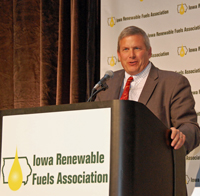 A great discussion at the 6th Annual Iowa Renewable Fuels Summit featured corn and cattle organizations on the same panel talking about the “Synergies of Livestock and Ethanol.”
A great discussion at the 6th Annual Iowa Renewable Fuels Summit featured corn and cattle organizations on the same panel talking about the “Synergies of Livestock and Ethanol.”
Moderator Iowa Agriculture Secretary Bill Northey opened the discussion by noting that sales of crops and livestock have risen as ethanol production has increased from $12 billion in 2002 - 6 billion in crop and 6 billion in livestock - to $24 billion in 2010, and 2011 is expected to be about $30 billion with at least $13 billion of that for livestock. “$13 billion on the livestock side versus $6 billion nine years ago,” Northey said. “Has ethanol been good for livestock agriculture in Iowa? I think very clearly.”
Listen to a brief interview with Secretary Northey here: Iowa Agriculture Secretary Bill Northey
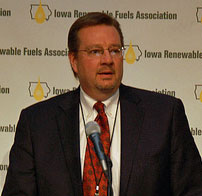 The livestock industry has traditionally been the most important market for corn, noted Iowa Corn Growers CEO Craig Floss, although use for ethanol has increased significantly in the past decade. “But a third of every one of those bushels that goes into an ethanol plant goes into DDGS,” he said, noting that Iowa corn farmers will continue to meet the growing demand for all markets - feed, fuel, food and exports.
The livestock industry has traditionally been the most important market for corn, noted Iowa Corn Growers CEO Craig Floss, although use for ethanol has increased significantly in the past decade. “But a third of every one of those bushels that goes into an ethanol plant goes into DDGS,” he said, noting that Iowa corn farmers will continue to meet the growing demand for all markets - feed, fuel, food and exports.
Listen to Craig’s part of the panel discussion here: Craig Floss on IRFA panel
 Iowa Cattlemen’s Association Executive Director Matt Deppe says it’s easy to see the benefits that distillers grains (DDGS) have brought to especially cattle feeders. “We look at it as a corn replacement,” Deppe says about DDGS. “It means that they (feedlot operators) have another option that’s cost effective to put into their rations.”
Iowa Cattlemen’s Association Executive Director Matt Deppe says it’s easy to see the benefits that distillers grains (DDGS) have brought to especially cattle feeders. “We look at it as a corn replacement,” Deppe says about DDGS. “It means that they (feedlot operators) have another option that’s cost effective to put into their rations.”
Listen to an interview with Matt Deppe here: Matt Deppe Interview
Photos from 2012 Iowa Renewable Fuels Summit
Posted By Cindy October 25, 2011
A new USDA report gives even more credit where credit is due to the value of the ethanol co-product known as distillers grains or DDGS in livestock and poultry feed.
The major finding of the report is that a metric ton of DDGS can replace an average of 1.22 metric tons of corn and soybean meal feed. “We found that, on average, for the past 5 crop years (2006/07-2010/11), 1 mt of distillers’ grains substitutes for about 1.22 mt of corn and soybean meal combined in the United States,” concludes the Economic Research Service (ERS) report. That means that almost a full 40 percent of the corn used for ethanol goes directly back into the feed supply.
As of 2010/11, DDGS replaced soybean meal as the number two feedstuff fed, and is second only to corn. An increasing amount of soybean meal is being replaced over corn in livestock rations. The report also found that as DDGS market share for beef cattle have declined, market shares for dairy cattle, swine, and poultry have increased. Beef cattle’s DDGS substitution rate for corn is remains higher than any other type of livestock/poultry but is the lowest for soybean meal.
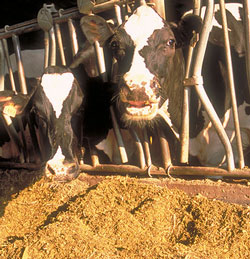 “This report reiterates what we have been saying for years: ethanol produces both fuel and food, in the form of high protein animal feed known as distillers grains,” said Growth Energy CEO Tom Buis, noting that distillers grains cost livestock producers about 25 percent less. “This valuable feed displaces a greater volume of field corn and soybeans, is less expensive to the producer and is much more nutritious for the animal.”
“This report reiterates what we have been saying for years: ethanol produces both fuel and food, in the form of high protein animal feed known as distillers grains,” said Growth Energy CEO Tom Buis, noting that distillers grains cost livestock producers about 25 percent less. “This valuable feed displaces a greater volume of field corn and soybeans, is less expensive to the producer and is much more nutritious for the animal.”
Geoff Cooper, Renewable Fuels Association Vice President of Research & Analysis, believes the report has important implications regarding ethanol’s impact on feed grains availability, feed prices, land use effects, and the greenhouse gas (GHG) impacts of producing corn ethanol.
“USDA’s new analysis clearly shows the importance of accurate DDGS accounting,” Cooper said. “The Environmental Protection Agency and CARB should immediately adopt these new findings into their GHG modeling for the RFS2 and LCFS. The resulting decrease in ethanol’s lifecycle GHG emissions could be significant.”
Earlier this year, RFA compared the production of DDGS to only the amount of corn used for feed. With estimated production of 39 million metric tons of distillers grains for feed in the current marketing year, that is the “equivalent to the 4th largest corn crop in the world, and is enough feed to produce 50 billion quarter-pound hamburgers – seven patties for each person on the planet – or enough to produce one chicken breast for every American every day for a year.” Accounting for soybean meal substitution, that makes even more!
What we call DDGS in general can also include a number of other individual ethanol co-product. There’s a whole alphabet soup of them - DDG, DWG, DDGS, DWGS, CDS, corn gluten feed (CGF), wet corn gluten feed (WCGF), and corn gluten meal (CGM). The report suggests that future industry surveys could be more precise if they estimated the effects of all the different ethanol coproducts on the U.S. feed complex.
This report includes some of the most specific and well-researched data on distillers grains production, consumption and the ratios by which it is being used in the different livestock and poultry markets. Read it here.
Posted By Cathryn September 16, 2011
In a world of splashy magazine covers and sexed-up headlines, it can be easy to obscure the facts with so-called data. Correlating figures to create data may sounds simple, but in choosing how to present the aggregated collection and conclusions of research, the data suppliers become the gatekeepers to the truth. To effectively assess the validity of the information, it is imperative to know exactly how they paint the picture that colors our perceptions.
In the case of U.S. Department of Agriculture figures on corn usage, government categories are obscuring reality and, in doing so, fueling food-versus-fuel panic based in incomplete information and, sometimes, intentionally obtuse interpretations. Now, the National Corn Growers Association wants to help the public understand what agricultural experts already know- corn used in ethanol production actually creates both feed and fuel.
In a recent interview, NCGA Vice President of Production and Utilization Paul Bertels got at the heart of the issue, and it is all about how USDA compiles the numbers. Noting that ethanol production has increased, he points out that, “basically one-third of what is being processed is coming right back into the livestock ration.”
Notably, this third is not reflected in corn usage data released by the agency. Instead, the total sum is attributed to ethanol with no accounting for the addition of high quality feed products that enter the livestock sector post-production.
“People get a little hysterical about the food vs. fuel,” said NCGA CEO Rick Tolman. “They believe that we are taking corn away from livestock producers.” That’s not the case, however. “The big difference is the pie is growing. Those pieces that have been going for feed and food are still there—they are not any smaller—it’s just that the pie got bigger.”
As in so many cases, the truth calms fears based in a lack of knowledge. Instead of perpetuating the pandemonium, realize that sensationalized stories sell magazines without regard for their impact upon the country. Buying into the mass hysteria only harms both farmers and the industry providing a domestic, renewable, sustainable fuel for the United States. Take a look at the broader picture instead of being blinded by skewed stats.
Posted By Cathryn July 19, 2011
Every reasonable adult knows that you always end up paying in the end. If you skimp in one area, you tend to make up the difference somewhere else in your life. So why does a small group of meat and poultry producers think that consumers are so reactionary they will thoughtlessly support short-sighted energy policies to save a few bucks?
Probably because they know that “curtailing” policies created to promote domestic, sustainable, renewable energy will fatten the wallets of their benefactors, not the animals they feed. If these poultry pushers and meat marketers have their way, the production of corn-based ethanol will cease altogether.
Not only would this flood the market with unsustainably cheap corn, it would impact what consumers pay at the pump. In modern America, almost every citizen relies on motorized transit, be it public or private. As studies have shown , without ethanol consumers will pay more for every gallon of fuel thus negating grocery aisle savings.
Higher fuel prices impact more than the cost of filling up the family car. Nearly all goods purchased in the United States are transported to the final point of sale from another destination. Higher fuel prices mean that each of these products will reflect the increase. By channeling all corn from ethanol production, they would have us trade a more reasonable fuel cost felt throughout the economy for momentary meat savings. But then again, poultry and meat are trucked to grocery stores too.
Posted By Cathryn June 29, 2011
 In an age of new media and self-proclaimed experts, getting credible information on food can feel like playing telephone in grade school. At the end of the game, the message doesn’t sound at all like the original, and no one is quite sure who changed it.
In an age of new media and self-proclaimed experts, getting credible information on food can feel like playing telephone in grade school. At the end of the game, the message doesn’t sound at all like the original, and no one is quite sure who changed it.
The many myths surrounding “magical” grass-fed beef illustrate this point precisely. Oft touted for its environmental and health benefits, proponents rely on the halo-effect that foodies grant nearly any item produced by a small-scale operation that involves a hefty price tag. But when you get down to it, statements promoting the sustainability of grass-fed beef are as accurate as if they had been transported through a children’s telephone play chain.
Luckily, real, non-biased experts are setting the record straight. Hudson Institute Center for Global Food Issues Director of Research and Education Alex Avery’s message is clear – corn-fed beef is a more environmentally-friendly, sustainable choice.
Noting that he “loves the sustainability question, if it’s an honest discussion,” Avery offers concrete data to back up his assertions. In place of dubious claims involving hip buzzwords, he explains his analysis citing studies that conclude corn production reduces greenhouse gases emissions and land use in beef production. An avid proponent of the practice, he confidently has presented arguments to corn-fed beef ranchers that they should place labels on their packaging to help consumers understand that their product is actually environmentally-friendly and sustainable.
It’s time to stop relying on feel-good messaging created by agenda-driven propagandists disguised as friendly hippies. Don’t play telephone. Share real, concrete information by posting a link to this article on your Facebook or Twitter page.
Posted By Cindy May 10, 2011
The livestock feed generated as a co-product of ethanol production is enough to make 50 billion quarter-pound hamburgers each year, according to a new report from the Renewable Fuels Association.
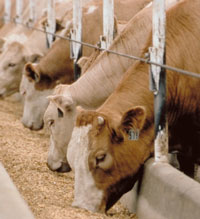 According to the report, “Fueling a Nation; Feeding the World,” ethanol producers are expected to turn out about 39 million metric tons of livestock feed in the form of distillers grains in the current marketing year. That amount is equivalent to the 4th largest corn crop in the world, and is enough feed to produce 50 billion quarter-pound hamburgers – seven patties for each person on the planet - or enough to produce one chicken breast for every American every day for a year.
According to the report, “Fueling a Nation; Feeding the World,” ethanol producers are expected to turn out about 39 million metric tons of livestock feed in the form of distillers grains in the current marketing year. That amount is equivalent to the 4th largest corn crop in the world, and is enough feed to produce 50 billion quarter-pound hamburgers – seven patties for each person on the planet - or enough to produce one chicken breast for every American every day for a year.
This is a message that needs to be shouted from the rooftops because it helps to visualize the point that ethanol uses much less of the nation’s corn supply than simple statistics imply. Last year, ethanol production provided 35 million metric tons (mmt) of livestock feed - more than the total amount of grain consumed by all of the beef cattle in the nation’s feedlots!
In other words, we are producing both food and fuel from every bushel of corn that goes into an ethanol plant. Why don’t people get this?
Posted By Mark December 1, 2010
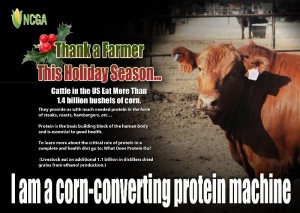 In this season of thankfulness and joy why not make sure that family farmers and ranchers make it on your Christmas list. They don’t want much; just a little appreciation for all they do to put clothes on your back, fuel in your car and food on your plate to nourish your body.
In this season of thankfulness and joy why not make sure that family farmers and ranchers make it on your Christmas list. They don’t want much; just a little appreciation for all they do to put clothes on your back, fuel in your car and food on your plate to nourish your body.
It all starts with knowledge because once the average American understands the business of farming better and has a better handle on how essential this industry of independent entrepreneurs is to us all then the thankfulness comes naturally.
And that’s what the National Corn Growers Association’s Holiday Viral Email campaign is about. The idea is to take one small part of agriculture and connect the dots. In this case the focus is on showing the important role corn and distillers grains from ethanol production to raising all kinds of livestock and related products and converting it to critical protein to keep us healthy and vital.
Attached to this blog is the second email in the series which showcases beef. The first message featured a turkey and went out the week of Thanksgiving. Chicken, pork and dairy are yet to come. You can view them all at the link above.
The idea of a viral email is simple; it starts with one person sending it to 10 people and asking them to send it to their friends, family, and business associates via email, facebook etc… This seemingly simple concept can result in thousands of people getting a positive message about our largest and most important industry.
I would appreciate your help in disseminating this to the widest possible audience. The entire image is clickable and goes to a backgrounder online related to the importance protein.
It’s easy…..just go to What Does Protein Do. At the bottom of the page you will find all of the images. Pick one and cut and paste it into an email along with a message asking your friends to pass it on. Come back each week between now and Christmas and send another one. The turkey is fair game again if you haven’t already sent it and you get bonus points for sending to non-Aggies.
Posted By Ken November 4, 2010
One of the chief arguments used by opponents of Proposition B in Missouri, which passed by a small margin in Tuesday’s election and restricts the size of dog breeding facilities and places burdens on them it exempts others from, was that it was a “foot in the door” for the Humane Society of the United States that would lead to similar regulations against livestock and other animal ag sectors in the state. That’s why its opposition was so broad for what could have been a very simple measure had it been worded right.
HSUS and its allies insisted all along it is just about the puppies and that agriculture is over-reacting in seeing a threat.
This morning, less than two days after Prop. B won, we see who was right. The groundwork is already being laid for extending HSUS influence in the Show-Me State, in the form of the popular comic strip Mutts – which has not only placed HSUS’s Wayne Pacelle on a pedestal in the past but actively promoted Proposition B before Tuesday’s election.
Didn’t take very long, did it now?

Page 2 of 6«12345...»Last »
 “This is an amazing difference from just five years ago,” said Purdue agricultural economist Dr. Chris Hurt. “The hog industry was largely set up with $2-2.50 corn going into 2006. After that we saw major increases in those corn prices.” Dr. Hurt spoke to swine veterinarians on the topic of “Global Feed Economics in a Biofuel World” during recent seminar put on by Boehringer Ingelheim Vetmedica (BIVI).
“This is an amazing difference from just five years ago,” said Purdue agricultural economist Dr. Chris Hurt. “The hog industry was largely set up with $2-2.50 corn going into 2006. After that we saw major increases in those corn prices.” Dr. Hurt spoke to swine veterinarians on the topic of “Global Feed Economics in a Biofuel World” during recent seminar put on by Boehringer Ingelheim Vetmedica (BIVI).





 A great discussion at the
A great discussion at the  The livestock industry has traditionally been the most important market for corn, noted Iowa Corn Growers CEO Craig Floss, although use for ethanol has increased significantly in the past decade. “But a third of every one of those bushels that goes into an ethanol plant goes into DDGS,” he said, noting that Iowa corn farmers will continue to meet the growing demand for all markets - feed, fuel, food and exports.
The livestock industry has traditionally been the most important market for corn, noted Iowa Corn Growers CEO Craig Floss, although use for ethanol has increased significantly in the past decade. “But a third of every one of those bushels that goes into an ethanol plant goes into DDGS,” he said, noting that Iowa corn farmers will continue to meet the growing demand for all markets - feed, fuel, food and exports. Iowa Cattlemen’s Association Executive Director Matt Deppe says it’s easy to see the benefits that distillers grains (DDGS) have brought to especially cattle feeders. “We look at it as a corn replacement,” Deppe says about DDGS. “It means that they (feedlot operators) have another option that’s cost effective to put into their rations.”
Iowa Cattlemen’s Association Executive Director Matt Deppe says it’s easy to see the benefits that distillers grains (DDGS) have brought to especially cattle feeders. “We look at it as a corn replacement,” Deppe says about DDGS. “It means that they (feedlot operators) have another option that’s cost effective to put into their rations.” “This report reiterates what we have been saying for years: ethanol produces both fuel and food, in the form of high protein animal feed known as distillers grains,” said Growth Energy CEO Tom Buis, noting that distillers grains cost livestock producers about 25 percent less. “This valuable feed displaces a greater volume of field corn and soybeans, is less expensive to the producer and is much more nutritious for the animal.”
“This report reiterates what we have been saying for years: ethanol produces both fuel and food, in the form of high protein animal feed known as distillers grains,” said Growth Energy CEO Tom Buis, noting that distillers grains cost livestock producers about 25 percent less. “This valuable feed displaces a greater volume of field corn and soybeans, is less expensive to the producer and is much more nutritious for the animal.”
 According to the report,
According to the report, 
